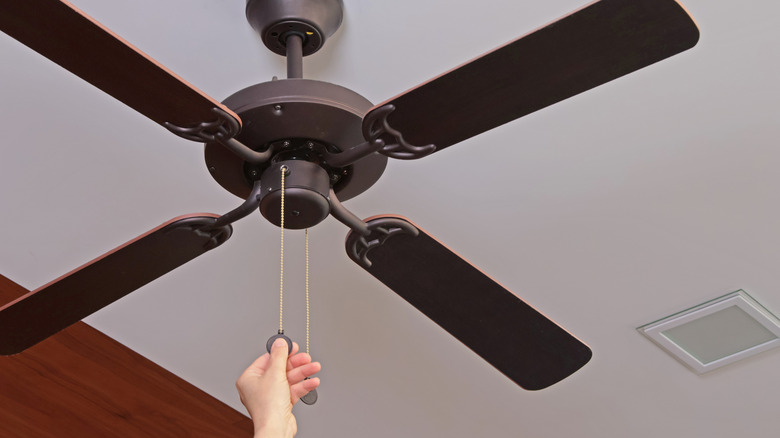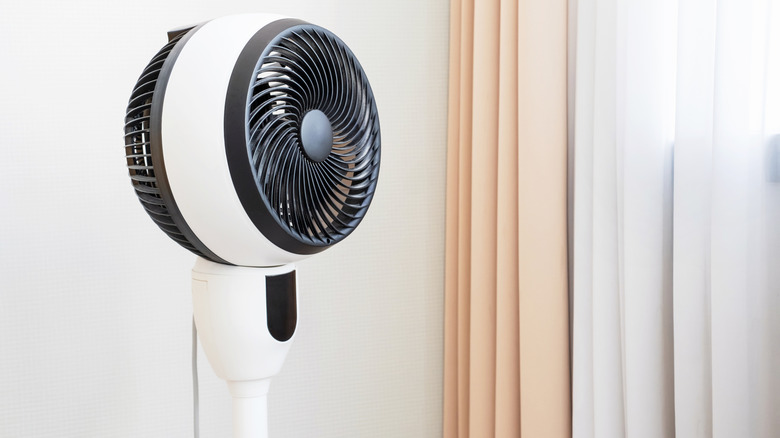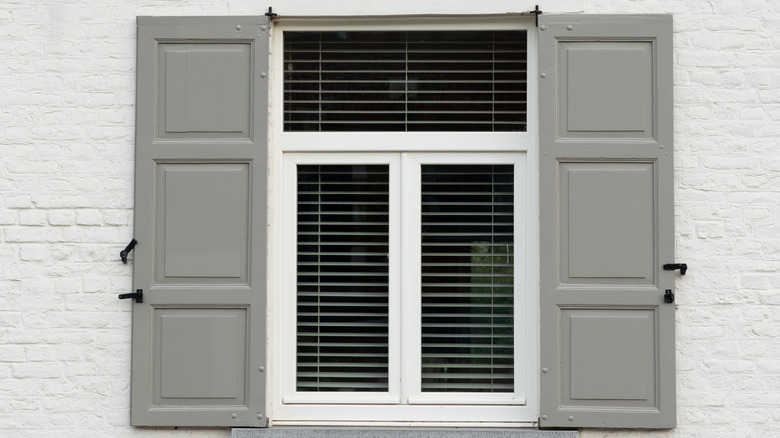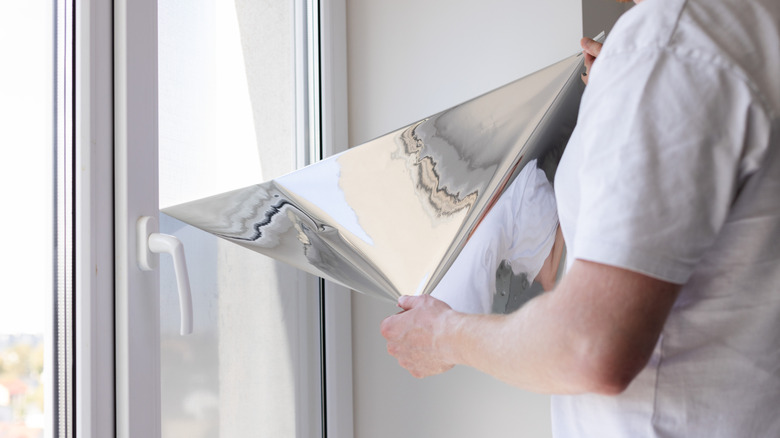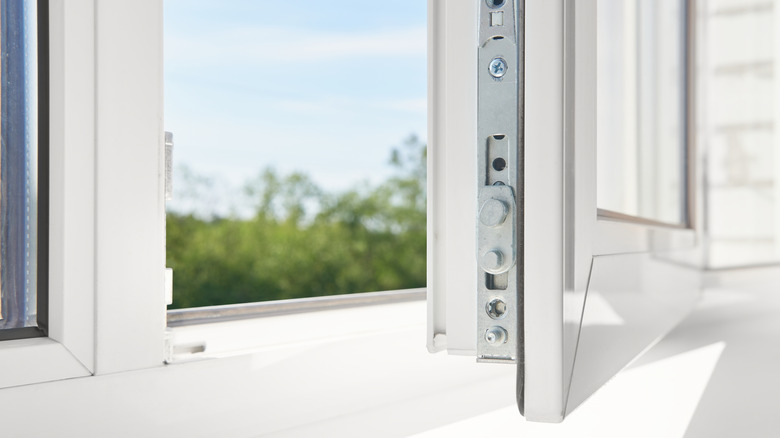Air Conditioner Alternatives That Are Worth Trying In A Small Room
We may receive a commission on purchases made from links.
When summer heat begins to ramp up, cooling your living spaces becomes a top priority. An air conditioner may not be the best option for the smaller spaces in your home, however, as they are not energy efficient and pose environmental concerns. In fact, the International Energy Agency points out that 10% of the electricity used around the globe is related to running air conditioners. The large amount of CO2 emitted by these units is also worrisome. Additionally, even the best air conditioning units are often bulky, taking up precious space in rooms that don't have much square footage to spare.
Fortunately, there are plenty of effective alternatives that can be utilized to keep your smaller living spaces cool, without relying on traditional air conditioning units or central air systems. From low-tech solutions like ceiling fans and thermal insulated blackout curtains to modern gadgets, such as portable evaporative coolers, heat pumps, and dehumidifiers, you'll discover these alternatives can make a noticeable difference in energy use, as well as your overall comfort within the home. Some of the options even reduce humidity while they provide relief from the heat, offering added benefits beyond temperature control. Here are nine air conditioner alternatives worth trying in your small room this summer season.
Lower temperatures with an evaporative cooler
Evaporative coolers, sometimes referred to as swamp coolers, work by pulling warm air through a moistened cooling pad and then blowing the newly cooled air back into the room. This process relies on the natural cooling effect of evaporation, making it an excellent choice for climates that experience a drier heat. Because they don't utilize refrigerants or compressors like traditional air conditioning units, they use less energy, saving you big on your electric bill. This also makes evaporative coolers an eco-friendlier choice. As an added bonus, they run much quieter than traditional AC units.
To use a swamp cooler in a small room, choose a compact tabletop or personal unit, like those made by Evapolar, that can sit neatly on a desk or shelf. These models take up minimal space and offer localized cooling where it's needed most, such as your bedroom, home office, or college dorm room. It's also important to select the right CFM rating for your space. Evapolar reports that a 750 CFM rating is best for a room that's approximately 250 square feet, although you may need a higher rating if your ceiling is above standard height. Another thing to be aware of is that swamp coolers raise indoor humidity, which may not be ideal if you live in a climate that is already experiencing excess moisture. Also, make sure to refill the water tank regularly and keep it clean to prevent unpleasant odors, as well as mold or mildew buildup.
Create a wind-chill effect with a ceiling fan
Ceiling fans help cool a room by creating a wind-chill effect that makes your skin feel cooler, even if the actual room temperature stays the same. For small rooms in particular, this effect can be significant, as a steady breeze helps prevent the air from becoming stale or stagnant. Unlike air conditioners, ceiling fans don't dry out the air or use refrigerants, making them a sustainable and energy-efficient choice. In fact, Cornell Cooperative Extension reveals that a ceiling fan costs just a penny each hour it is operating. The means if you ran the fan eight hours a day, you'd only add $2.24 to your monthly electricity bill.
Choosing the best ceiling fan for your small space is important. You want the fan to not only fit the room, but also add a touch of style. Thankfully, there are more modern designs, such as "fandeliers" like the OPKMB Boho Caged Fandelier, that fit both of these requirements. Fandeliers use smaller fan blades and place those blades in the center of a lighting fixture that resembles a chandelier. Since they are less bulky than traditional ceiling fans, they work well in tighter rooms that have lower ceilings, and are much less of an eyesore. When shopping, select a model with a reversible motor, and then run the fan counterclockwise using one of the higher speed settings to push cool air downward. Just be mindful of ceiling height and clearance if the room is compact. Flush-mounted designs may be the best way to go.
Set up a box or tower fan for relief from the heat
Just like ceiling fans, box and tower fans work by circulating air around the room, helping your body cool itself through air flow. While they don't actually lower the room's temperature, the breeze they generate can make it feel several degrees cooler, which may be all you need to feel relief on a warmer summer afternoon. Box fans offer the option of being placed on a floor, as well as on a desk or dresser, depending on the amount of available space in your room. Tower fans are also a great match for small rooms, as they can be found in slim models that take up minimal floor space. Most tower fans also include an oscillation option that helps move the air more evenly around the room.
When shopping for box or ceiling fans for your small room, consider added features, such as a choice of fan speeds or the ability to position the fan at a variety of angles. Some smaller box fans also come with a built-in clip, which is ideal for a desk or nightstand. Another trick that many use to keep a room cool is to place a bowl of ice or a frozen water bottle in front of the fan. This simple hack can slightly chill the air as it passes over the ice, creating a refreshing, low-tech cooling system. Just keep in mind that fans can stir up dust, so they may not be ideal for allergy sufferers, unless cleaned regularly.
Install exterior shutters or shades to keep the heat out
Another air conditioner alternative worth trying in a small room is to install exterior shutters or shades. These handy additions block sunlight before it even reaches your windows, which in turn significantly reduces the temperatures in the rooms on the other side of the windows. According to PennState, exterior shading can actually lower indoor temperatures by up to 20 degrees Fahrenheit, which is especially noticeable in a small room. In addition to being highly effective at lowering the indoor thermometer, these barriers are also cost effective. They won't add to your electric bill, and you only need to purchase them once.
Depending on where you live, you may need to get permission to install shutters or shades. Renters will need to consult with homeowners, and homeowners will need to speak with their local building department or homeowners association. Once you have the go ahead, you can install the shutters or shades. This will require a set of tools, and in some cases, the help of a friend. In the event that permission to add the exterior is denied, consider planting tall trees that will cast shade on the window.
Hang thermal insulated blackout drapes to regulate room temperatures
In addition to being an excellent cooling product for college students, thermal insulated blackout drapes are an effective way to cool any small room. When installed over a window, they work the same way as their exterior counterparts, blocking the sunlight that causes a room to heat up. The U.S. Department of Energy states that, as long as you opt for medium-colored blackout drapes that feature a white plastic back, you can make your small room a whopping 33% cooler! This is huge, as smaller rooms are quick to build up heat, leaving you feeling like you're baking in an oven.
To implement this air conditioner alternative, hang thermal insulated blackout curtains that fully cover the window frame. This requires gathering the window measurements before you head to the store and keeping in mind that you'll need a medium-colored option for the hack to be the most effective. Since blackout drapes don't take up any floor space, they can be used in a room of any size without issue. The only downside to this alternative is that the curtains will leave the room dark, as no natural light will be able to enter through the window. That means you'll likely need to use artificial lights during the day when the drapes are closed.
Use a dehumidifier to make the air feel less sticky and hot
As those who live in humid climates know, humid air prevents your body from releasing heat through sweat, leaving you feeling sticky, hot, and very uncomfortable. Since moisture can accumulate quickly in a small room, reducing the humidity can make a big difference in how enjoyable the space feels. Setting up a dehumidifier is a great way to accomplish this, as it pulls moisture from a small room very well. Of course, dehumidifiers don't actually lower the temperature in a room, but they will save on energy costs when used in place of an air conditioning unit. If you find that you simply can't live without an air conditioner, you can still save money by incorporating a dehumidifier, as you'll be able to raise the thermostat a few degrees, causing the air conditioner to turn on less often.
To use a dehumidifier in a small room, look for compact or mini models that can easily fit on the floor or even a shelf. You don't need a unit with a large capacity, as a 10-pint option can handle a room as large as 500 square feet. Run the machine during the hottest parts of the day or whenever the room starts to feel damp. Some models offer a humidistat, which allows you to set the unit to your desired humidity level. It will then automatically shut off once that percentage has been reached. Keep in mind that dehumidifiers collect the moisture they extract from the air in a tank that must be regularly emptied. Otherwise, you risk the container overflowing or developing mold.
Block heat with reflective window film
The trouble with window treatment fabrics meant to keep heat out, such as thermal blackout drapes, or exterior shutters is that they block your view of the great outdoors and leave your living areas dark and gloomy. If you're looking for a similar cooling effect, but without the obstructed light, opt for reflective window films instead. Reflective window films are a sleek, space-saving solution for small rooms that block heat while still allowing natural light to permeate through. Unlike blackout curtains, these films reflect infrared rays and UV radiation, while still providing visibility, making your small room feel cooler and brighter at the same time.
The installation of reflective window film sheets is relatively easy, requiring that you simply clean the window, apply the film, and then work out any air bubbles using a smoothing tool. There are a few numbers you need to look for when shopping, however. The solar heat gain coefficient (SHGC) and visible transmittance (VT) numbers let you know how well the film reduces heat and how much light it allows into your space. Opt for a lower SHGC to reduce heat and a moderate VT (the higher the VT, the more light will come in), so you have enough light and visibility to meet your needs. One caveat to this alternative is that many window manufacturers will void their warranties if a homeowner installs reflective window films on them, so make sure you check your warranty before you go with this option.
Utilize cross ventilation to reduce room temperatures
Another way to cool down your small room is to ensure you're opening your windows the right way. Cross ventilation is a natural cooling method that keeps air moving through your space instead of letting it become hot and stagnant. By opening two windows or doors on opposite sides of the room, you allow fresh air to flow through. This technique is especially effective at night when outdoor temperatures drop and early in the morning before temperatures begin rising again.
To boost cross ventilation in a small room, consider adding a fan facing inward from one window to draw cooler air in and another on the opposite side facing outward to push warm air out. Even if your room only has one window, opening a door across the hall or into another room can help create better airflow. This method costs nothing and works surprisingly well in small rooms, but it's weather-dependent and less effective on windless or humid days.
Drape a wet sheet in front of a window to achieve a cooling effect
In addition to cooling a small space with a cross breeze, homeowners can also make use of an old-school trick that utilizes the science of evaporation to cool incoming air. By hanging a wet sheet or towel in front of an open window, the air that passes through it evaporates some of the water. The evaporated water droplets absorb heat, which helps to slightly cool the air in the room. Basically, it's like a DIY swamp cooler. If you're looking for quick, temporary relief, this alternative is worth trying.
To try the wet sheet method, you'll want to soak a lightweight sheet in cold water, wring it out a bit, and then hang it in front of a window with a breeze. You could also set it in front of a fan if you can't open the window due to foul weather. Just like cross breezes, this option is especially useful at night when outside temperatures are cooler. The sheet will need to be re-wet periodically, and you'll want to protect furniture or floors from dripping water. While not a long-term fix, it's a quick and affordable way to get a bit of relief in a stifling small room. This air conditioner alternative can also be implemented alongside one of the other options for added relief, such as turning on a ceiling fan.

